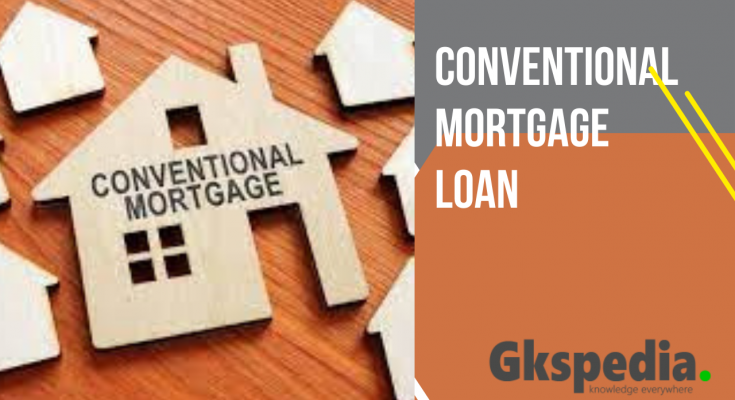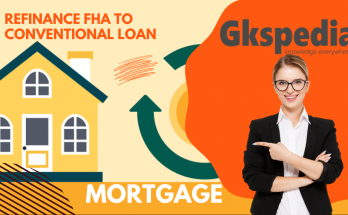Introduction: When it comes to financing your dream home, Conventional Mortgages are a tried-and-true option that has helped millions of homeowners achieve their goals. If you’re in the market for a mortgage or simply looking to expand your knowledge of home financing, understanding what a Conventional Mortgage entails is essential. In this comprehensive guide, we will unravel the intricacies of Conventional Mortgages, exploring how they work, the benefits they offer, and important considerations for prospective homebuyers. Join us as we embark on a journey to demystify Conventional Mortgages and provide you with the knowledge you need to make informed decisions on your path to homeownership.
What Is a Conventional Mortgage
“Conventional Mortgage” or “Conventional Loan” are terms you’ll come across when searching for a mortgage. After all, this popular form of mortgage is offered by most lenders.
A regular loan is the best option for borrowers with a good credit rating and the ability to pay a down payment of at least 3% or more. Find out what it traditionally means in the mortgage industry and whether it’s the right mortgage for you.
A traditional loan is a type of mortgage that is not guaranteed by a government agency such as the Department of Veterans Affairs. Traditional mortgages often meet down payment and income requirements set by Fannie Mae and Freddie Mac and comply with loan limits set by the Federal Home Finance Administration (FHFA).
A credit score of at least 620 is usually required to qualify for a traditional loan, but scores above 740 can help you get the best interest rates. Depending on your financial situation and how much you owe, you may be able to pay a down payment of as little as 3% on a traditional loan. (But keep in mind that the higher the down payment, the lower the interest rate may be.
A traditional mortgage or loan is any type of home buyer loan that is not offered or guaranteed by a government agency. Conventional mortgages, on the other hand, are offered by private lenders including banks, credit unions, and mortgage lenders. However, some traditional mortgages may be guaranteed by his two government-sponsored companies. Federal Home Loan Association (Fannie Mae); Federal Mortgage Mortgage Company (Freddie Mac).
Understanding Conventional Mortgages and Loans
Traditional mortgages usually have fixed interest rates. That is, the interest rate does not change over the life of the loan. Traditional mortgages and loans are not federally insured and are typically subject to stricter credit requirements from banks and creditors.
There are several government agencies that secure bank mortgages, such as the Federal Housing Administration (FHA). FHA has a low down payment and no closing costs.
His two other agencies are in the United States. Both the Veterans Affairs (VA) and USDA Rural Housing Service require no down payment.
Borrowers must, however, fulfill standards in order to be eligible for these schemes.
Types of Conventional Loans?
There are many different types of traditional loans that you may come across when comparing lenders and mortgage options. Here are the most common ones and how they work.
Compliant Conventional Loans: Compliant Conventional Loans are loans that meet the criteria set by Fannie Mae and Freddie Mac and include the maximum loan amounts listed above.
Jumbo Loans: Jumbo loans allow you to borrow more than the maximum credit limit of a matching loan. However, they usually require a higher credit score, a lower debt-to-income (DTI) ratio, and larger down payment.
Portfolio Loans: Portfolio loans are traditional loans that the lender holds in its own portfolio rather than selling them on the secondary market. This option gives lenders more flexibility than the standards of Fannie Mae and Freddie Mac. Especially when it comes to credit scores and DTI.
Subprime Loans: Compliant loans must have a DTI of less than 50% and a credit score of 620 or higher. But if your credit isn’t good enough, you can qualify for a subprime mortgage loan.
Amortized Traditional Loans: These loans are fully amortized, allowing homebuyers to receive consistent monthly payments throughout the life of the loan. Traditional amortizing loans can have fixed or adjustable mortgage interest rates.
Variable Rate Loans: A fixed-rate mortgage loan has the same interest rate for the life of the loan, so your monthly payments are the same. However, variable-rate mortgages have a fixed interest rate for a set period of time (usually 3 to 10 years for him). The interest rate is then adjusted annually to the current market rate.
Conventional vs. Conforming
Traditional loans are often erroneously referred to as conforming mortgages or loans. Although there is some overlap, the two are different categories. A qualified mortgage is a mortgage whose underlying terms meet Fannie Mae’s and Freddie Mac’s funding standards. Chief among these is the dollar limit set annually by the Federal Housing Finance Agency (FHFA). In most of the continental US, loans cannot exceed $647,200 in 2022 (up from $548,250 in 2021). Therefore, all compliant loans are conventional, but not all conventional loans are compliant. For example, an $800,000 Jumbo Mortgage is a Traditional Mortgage, but not a Conformed Mortgage. This is because it exceeds the amount allowed for Fannie Mae or Freddie Mac collateral.
8.3 million households had mortgages that were FHA-insured in 2020.
The secondary market for traditional mortgages is very large and fluid. Most traditional mortgages are packaged in mortgage-backed securities that trade on an established futures market known as the TBA market. Many of these traditional pass-through securities are further securitized with collateralized mortgage obligations (CMOS).
How a Conventional Mortgage or Loan Works
Since the subprime mortgage collapse in 2007, lenders have tightened their lending requirements. For example, “no verification” and “no down payment” mortgages have gone with the wind, but overall, most of the basic requirements have remained the same.
Prospective borrowers are required to complete a formal mortgage application (usually pay an application fee) and provide the required documents to the lender for a comprehensive check of background, credit history, and current creditworthiness. I have.
Private Mortgage Insurance
If you can afford less than 20% on a traditional loan, you should pay for Personal Mortgage Insurance (PMI). PMI protects mortgage investors in the event of loan default. The cost of PMI depends on the type of loan, credit rating, and down payment amount.
There are various methods to pay for PMI without adding it to your monthly mortgage payment. Some buyers pay an upfront fee that is included in the closing cost. Others pay it in the form of slightly higher interest rates. Choosing a PMI payment method requires counting the numbers to determine which option is best for you.
The beauty of PMI is that it’s not permanently part of the loan. You can ask the lender to remove her PMI from your mortgage payments once your home equity reaches 20% of his on a regular mortgage payment schedule.
Once the home’s value reaches 20%, you can ask the landlord for a new quote so that you can recalculate her PMI requirements using the new value. Lenders automatically remove PMI from loans when a home’s equity reaches 22%.
Required Documentation
No property is 100% financed. When reviewing assets and liabilities, the lender does more than just check if monthly mortgage payments, which typically should not exceed his 28% of gross income, are possible.
The lender will also check if you can pay a down payment for the property (and if so how much) and any other upfront costs such as B. Lending or Underwriting Fees, Brokerage Fees, and Settlement or Closing Fees. All of these can add significantly to your mortgage costs. The items you need are:
Proof of Income
These documents you need to proceed with your application
30-day payslip showing income and year-to-date income
Two years of federal tax returns
His 60-day or quarterly statement of all asset accounts including checking, savings and investment accounts
Two-Year W-2 Statement
Borrowers must also provide proof of additional income such as child support or bonuses.
Assets
To demonstrate that you have financial reserves in addition to the funds for the down payment and closing fees on the home, you will need to provide bank statements and investment account statements. You will need gift letters, which attest that the funds are not loans and do not have to be repaid if you get money from a friend or relative to help with the down payment. Frequently, notarization of these letters is required.
Employment Verification
Today’s lenders want to ensure they only lend to borrowers with solid professional backgrounds. In addition to wanting to check your payslip, your lender may call your employer to confirm you are still employed and to verify your salary. If you have recently changed jobs, your lender may wish to contact your previous employer. Self-employed borrowers are required to provide important additional documents related to their business and income.
Other Documentation
The lender will require a copy of your driver’s license or ID card and will require your social security number and signature so the lender can obtain your credit report.
Credit Score: In most cases, you need a minimum credit score of 620 to qualify for a traditional loan. When you apply, the lender will look at your credit history to determine if you have good credit. Otherwise, the loan may not be approved.
Debt-to-Income Ratio: The Debt-to-Income Ratio (DTI) is a percentage that indicates how much of your monthly income is used to pay off debt. DTI can be calculated by summing the minimum monthly payments of all debt (student loans, car loans, credit cards, etc.) and dividing by your total monthly income. For most conventional loans, the DTI should be 50% or less.
Loan Size: For compliant traditional loans, the loan must be within the loan limits set by Fannie Mae and Freddie Mac. Credit limits change annually. In 2022, the compliant credit limit for single-family homes is $647,200. However, there are exceptions. Alaska, Hawaii, and other high-cost areas of the country have higher credit limits of up to $970,800. Visit the Federal Housing Finance Agency website to check the credit limits for your area.
What advantages of a Conventional Loan?
That’s why it’s important to understand the pros and cons of each option before making a decision. Below are just some of the benefits you can get from traditional loans.
Low cost: A good credit score can help you qualify for low-interest rates. You can also request the release of the insurance obligation once the loan-to-value ratio reaches 80%. In contrast, mortgage insurance premiums associated with FHA loans can remain in place for the life of the loan, and the same is true for security premiums on USDA loans.
Higher Credit Limits: Conforming loans have limits, while traditional jumbo loans can be higher if needed. A government-guaranteed loan may not provide such flexibility.
Some Flexibility: Private mortgage lenders have more flexibility with traditional loans than with government-guaranteed loans, mainly because they don’t have to follow guidelines set by these government agencies.
Downsides of a Conventional Loan
While traditional loans have some advantages over government-backed loans, they also have some drawbacks to consider.
Higher credit score requirements: Generally, you need a minimum credit score of 620 to qualify for a compliant traditional loan. This is higher than the requirements of some government-sponsored loans.
Higher Down Payment Requirement: Some traditional loan programs don’t let you set a 3% or no down payment when you buy your first home, but expect you to pay 5.00. In contrast, FHA loans require a minimum 3.5% down payment, and USDA and VA loans have no down payment requirements at all.
Stricter eligibility guidelines: Government-guaranteed mortgages pose less risk to lenders, so it may be easier to take one of these loans, as long as you meet the agency’s eligibility requirements. I have. On the other hand, traditional loans allow the lender to take a higher risk on the loan and therefore have a closer look at a person’s financial situation.
Interest Rates for Conventional Mortgages
Traditional loan interest rates are usually higher than government-backed mortgages. B. FHA loans (although these loans typically require the borrower to pay mortgage insurance premiums, which can be similarly costly in the long run).
The interest rate on a traditional mortgage depends on several factors, including the terms of the loan (term, amount, whether the interest rate is fixed or variable) and current economic or financial market conditions. Interest rates for mortgages are established by mortgage lenders using their projections for inflation. Supply and demand for mortgage-backed securities also affect prices. With our mortgage calculator, you can see how different interest rates affect your monthly payments.
Who May Not Qualify
In general, people just starting out in life, those with moderately high debt, and moderate credit ratings often struggle to qualify for a conventional loan.
Have experienced bankruptcy or foreclosure within the last 7 years
Credit score less than 650
20% or less than 10% of the home purchase price for a DTI down payment greater than 43D44
However, if you decline a mortgage, ask your bank why in writing. You can qualify for other programs that help you get your mortgage approval.
For example, if you have no credit history and are buying a home for the first time, you may be eligible for an FHA loan. FHA loans are loans specifically tailored for first-time homebuyers. As a result, FHA loans have different eligibility and credit requirements, including a lower down payment.
Down Payment
A security deposit of 20% or more of the home purchase price is possible at any time. Lenders may accept less, but if they do, they may require the borrower to take out personal mortgage insurance and pay monthly premiums until the home is at least 20% owned. Often.
Additionally, traditional mortgages are often the best or only option for homebuyers looking to buy for investment purposes, a second home, or a property priced above $500,000.
For first-time homebuyers, traditional mortgages are available with as little as a 3% down payment. However, down payment requirements may vary depending on your personal circumstances and the type of loan or property you are receiving.
If you’re not new to buying a home or don’t exceed 80% of the median income in your area, the down payment requirement is 5%.
If the home you buy is not a single-family home (i.e., multiple units), you may have to pay 15%.
If you are buying a second home, you will need to pay at least a 10% down payment.
For variable-rate mortgages, the minimum down payment requirement is 5%. To refinance a traditional loan, a minimum equity capital of 3% is required. In any case, at least 5% equity is required. You must hold at least 20% equity in your home when refinancing your payments.
Debt-to-Income
Acceptable debt-to-income ratio (DTI). This is the sum of your monthly debt payments, such as credit card and loan payments, compared to your monthly income. Ideally, the debt-to-income ratio should be around 36% and not exceed 43%. In other words, you should spend less than 36% of your monthly income on debt payments.
Credit Score
A credit score is a numerical representation of a borrower’s ability to repay loans. A credit score includes a borrower’s credit history and the number of delinquencies. Approval may require a credit score of at least 620 and possibly higher. The higher the score, the lower the interest rate on the loan, reserving the best conditions for those with the highest scores





After I originally commented I appear to have clicked on the -Notify me when new comments are added- checkbox and from now on each time a comment is added I recieve 4 emails with the same comment. Is there a means you can remove me from that service? Many thanks!